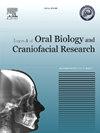头颅测量分析诊断错牙合特征的一致性
Q1 Medicine
Journal of oral biology and craniofacial research
Pub Date : 2025-05-04
DOI:10.1016/j.jobcr.2025.04.012
引用次数: 0
摘要
背景:不同头颅测量分析的结果相互矛盾是具有广泛影响的常见问题,但尚未得到应有的重视。本研究评估了常见的头颅测量分析在诊断错牙合的基本牙齿-骨骼特征方面的一致性。材料和方法采用Downs、Steiner、Wits、Tweed、Bjork、Ricketts和McNamara分析方法对125张侧位脑电图进行数字分析。根据每项分析建立矢状颌关系(1/2/3类)、上颌和下颌位置(正颌/前颌/后颌)、生长模式(正常/低发散/超发散)和上下切牙位置(正常/前倾/后倾)的诊断。使用Kappa统计评估分析之间的一致程度。结果对矢状颌关系的分析总体一致性中等[k = 0.41(0.37-0.45)],对生长方式[k = 0.24(0.20-0.27)],下颌位置[k = 0.25,(0.20-0.30)],上切牙(k = 0.38, CI = 0.32-0.44)和下切牙[k = 0.21(0.17-0.25)],上颌位置[k = 0.18(0.13-0.23)]的分析一致性较低[k = 0.18(0.13-0.23)]。对于分析的两两比较,矢状颌关系的一致性是中等到实质性的(除了涉及麦克纳马拉分析的比较),其他变量的一致性是轻微到中等的。此外,正常牙面关系的诊断(1类和正常的骨骼模式,正颌位置和正常门牙位置)比异常亚群的诊断更不一致。结论在矢状颌关系方面,头颅测量分析的一致性中等,而在大多数其他牙齿-骨骼特征方面,其一致性仅为一般。麦克纳马拉的分析显示,他与其他人的观点不太一致。这些突出表明需要采取更加谨慎和科学的方法来进行头测术。本文章由计算机程序翻译,如有差异,请以英文原文为准。
Agreement between cephalometric analyses in diagnosing the dento-skeletal characteristics of malocclusion
Background
Conflicting results from different cephalometric analyses is a common problem with broader implications but has not received due attention. This study evaluated the agreement between common cephalometric analyses in diagnosing the essential dento-skeletal characteristics of malocclusion.
Material and methods
A total of 125 lateral cephalograms were analyzed digitally using Downs, Steiner, Wits, Tweed, Bjork, Ricketts, and McNamara analysis. The diagnosis of sagittal jaw relation (Class 1/2/3), maxillary and mandibular positions (Orthognathic/Prognathic/Retrognathic), growth pattern (Normodivergent/Hypodivergent/Hyperdivergent), and upper and lower incisors positions (Normal/Proclined/Retroclined) were established based on each analysis. The extent of agreement between the analyses was assessed using Kappa statistics.
Results
The overall agreement between analyses was moderate for sagittal jaw relationship [k = 0.41 (0.37-0.45)], fair for growth pattern [k = 0.24 (0.20-0.27)], mandibular position [k = 0.25, (0.20-0.30)], upper incisor (k = 0.38, CI = 0.32-0.44) and lower incisor [k = 0.21 (0.17-0.25)] positions, and only slight for maxillary position [k = 0.18 (0.13-0.23)]. For pairwise comparisons of analyses, the agreement was moderate to substantial for the sagittal jaw relationship (except for comparisons involving McNamara analysis) and slight to moderate for other variables. Also, the diagnosis of normal dentofacial relationships (Class 1 and normodivergent skeletal pattern, orthognathic jaw positions, and normal incisor positions) was less consistent than those of deviant subgroups.
Conclusions
The agreement between the cephalometric analyses evaluated was moderate for sagittal jaw relation and only fair for most other dento-skeletal characteristics. McNamara's analysis showed less agreement with others. These highlight the need for a more cautious and scientific approach to Cephalometrics.
求助全文
通过发布文献求助,成功后即可免费获取论文全文。
去求助
来源期刊

Journal of oral biology and craniofacial research
Medicine-Otorhinolaryngology
CiteScore
4.90
自引率
0.00%
发文量
133
审稿时长
167 days
期刊介绍:
Journal of Oral Biology and Craniofacial Research (JOBCR)is the official journal of the Craniofacial Research Foundation (CRF). The journal aims to provide a common platform for both clinical and translational research and to promote interdisciplinary sciences in craniofacial region. JOBCR publishes content that includes diseases, injuries and defects in the head, neck, face, jaws and the hard and soft tissues of the mouth and jaws and face region; diagnosis and medical management of diseases specific to the orofacial tissues and of oral manifestations of systemic diseases; studies on identifying populations at risk of oral disease or in need of specific care, and comparing regional, environmental, social, and access similarities and differences in dental care between populations; diseases of the mouth and related structures like salivary glands, temporomandibular joints, facial muscles and perioral skin; biomedical engineering, tissue engineering and stem cells. The journal publishes reviews, commentaries, peer-reviewed original research articles, short communication, and case reports.
 求助内容:
求助内容: 应助结果提醒方式:
应助结果提醒方式:


